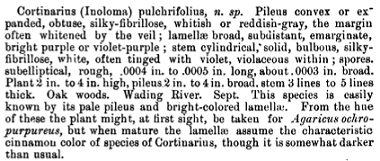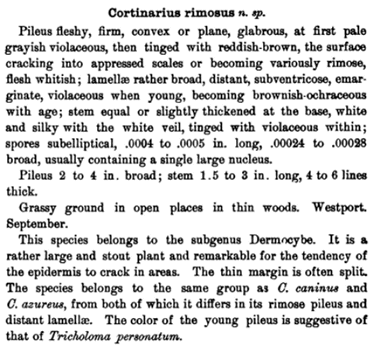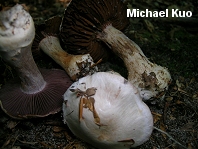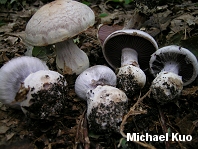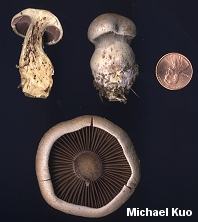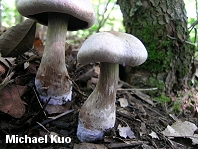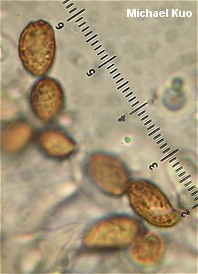| Major Groups > Gilled Mushrooms > Dark-Spored > Cortinarius > Cortinarius subpulchrifolius |

|
Cortinarius subpulchrifolius [Basidiomycetes > Agaricales > Cortinariaceae > Cortinarius ... ] by Michael Kuo Here is a North American member of the Cortinarius alboviolaceus species group, originally described from Michigan, separated from the others in the group on the basis of the following features:
Cortinarius subpulchrifolius appears in the summer and fall, and is apparently common in the Great Lakes region. Its colors and stature are reminiscent of Laccaria ochropurpurea, but that species has a white spore print and gills that remain purplish, rather than eventually becoming rusty brown. Description: Ecology: Mycorrhizal with hardwoods, especially oaks; growing alone or scattered; summer and fall; known from the Great Lakes region. Cap: 4-10 cm; convex, becoming broadly convex; dry; silky; gray to silvery buff, sometimes with pale lilac shades when young; developing rusty to brownish areas and stains. Gills: Attached to the stem; distant or nearly so; thick; deep dusky purple when young, becoming cinnamon to rusty brown; covered by a white cortina when young. Stem: 5-10 cm long; 1-1.5 cm thick at the apex; usually club-shaped; dry; silky; pale lilac near the apex, silvery to grayish elsewhere; sheathed or "booted" with white to pale lilac veil material over the lower portion; often with a rusty ring zone. Flesh: Whitish, grayish, or pale lilac. Odor: Usually somewhat fragrant; sometimes not distinctive. Chemical Reactions: KOH on cap surface negative. Spore Print: Rusty brown. Microscopic Features: Spores 8-10 x 5-6.5 µ; flask-shaped; moderately and widely roughened. Cheilo- and pleurocystidia absent. Pileipellis a cutis. REFERENCES: Kauffman, 1918. (Kauffman, 1918; Kauffman, 1936; Smith, Smith & Weber, 1979.) Herb. Kuo 07170406, 09110505, 09111016. Two species described by Peck, Cortinarius pulchrifolius and Cortinarius rimosus, are similar (see Peck's descriptions, below). The former, apparently, has no "boot" of veil material around the stem base, and the latter has a cap that becomes cracked and reddish brown with maturity. Both species are stocky in comparison to Cortinarius subpulchrifolius. Whether or not contemporary investigation of Peck's species would reveal that they represent the same species in different stages of development or, in the case of Cortinarius pulchrifolius, poor documentation of stem details, remains to be seen. It is at least conceivable that Peck's species are the same, and are identical to Kauffman's Cortinarius subpulchrifolius. Peck, C. H. (1883), Annual Report of the New York State Museum 33: 20. Peck, C. H. (1897), Annual Report of the New York State Museum 48: 12. This site contains no information about the edibility or toxicity of mushrooms. |
© MushroomExpert.Com |
|
Cite this page as: Kuo, M. (2011, December). Cortinarius subpulchrifolius. Retrieved from the MushroomExpert.Com Web site: http://www.mushroomexpert.com/cortinarius_subpulchrifolius.html |
